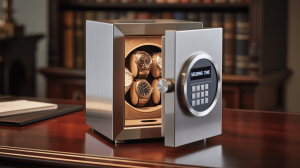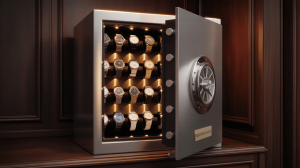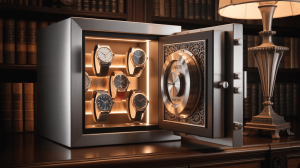Safe for Watches: A Must-Have for Luxury Watch Owners. But here’s the kicker… Your timepieces represent craftsmanship, heritage, and sizeable investment. Without proper storage, theft, fire, or moisture can wreak irreversible damage. A dedicated watch safe delivers both high security and environmental protection—essential for any luxury collection.
1. Why Every Luxury Watch Owner Needs a Safe
Luxury watches can cost thousands or even hundreds of thousands of dollars. A specialized safe uses reinforced steel, heavy-duty locking bolts, and precise locking mechanisms—mechanical dials, electronic keypads, or biometric scanners—to deter theft. Concealed anchor points allow bolting to floors, walls, or furniture, making removal nearly impossible. Insurance premiums often drop when watches are stored in certified safes, offsetting the initial outlay.
| Security Feature | Description | Benefit |
|---|---|---|
| Reinforced Steel Walls | Resistant to drilling and prying | High physical protection |
| Locking Bolts | Multiple thick steel bolts | Prevents forced entry |
| Lock Type | Mechanical, electronic, biometric | Tailored access control |
2. Understanding Your Insurance Requirements
Most insurers require UL RSC or ETL burglary ratings for coverage. Verify whether your policy mandates a minimum fire rating—often UL 72 Class 350 for 30–60 minutes at 1,200 °F. Present certification documents when filing claims. A certified safe demonstrates due diligence, simplifying claims after theft or disaster.
3. Fire Protection: Safeguarding Movements and Oils
Even a brief fire can heat interiors beyond 350 °F, damaging lubricants and delicate mechanisms. Choose safes with UL 72 fire ratings and intumescent seals that expand under heat to block smoke and flames. Insulating materials—gypsum boards or ceramic composites—minimize heat transfer, preserving your watches’ precision and finish.
4. Choosing the Right Size and Capacity
Measure your current collection plus planned additions. Account for pillow height (~1.5–2 inches) and extra accessories—straps, tools, warranty cards. Compact safes (6×8×6 inches) hold 2–4 watches; mid‑size (8×10×8) fits 4–6; larger models (12×12×10) accommodate 8–12. A snug fit prevents movement during retrieval.
| Dimensions (W×D×H) | Watch Capacity | Extra Storage |
|---|---|---|
| 6×8×6 in | 2–4 | Minimal (tools/straps) |
| 8×10×8 in | 4–6 | Moderate |
| 12×12×10 in | 8–12 | Plenty for full kits |
5. Locking Mechanism Options Explained
Mechanical dials require no power but can be slower to operate. Electronic keypads offer multiple user codes, time‑delay settings, and audit logs. Biometric scanners grant instant access via fingerprint but need occasional re‑enrollment. Dual‑lock setups combine methods—keypad plus biometric—for layered defense. Match your usage habits: convenience versus redundancy.
6. Exterior Materials and Aesthetic Integration
A luxury watch safe should complement your décor. Powder‑coat steel finishes in matte black or grey offer stealth. Stainless steel exteriors provide modern sheen. For a high‑end touch, select wood veneer panels or leather wraps—available in custom colors. Ensure materials resist corrosion, especially in humid climates.
7. Interior Organization and Protection
A structured interior prevents scratches and tangling. Foam or velvet‑lined watch pillows cradle each piece. Adjustable trays let you customize layouts for different watch diameters and strap sizes. Removable winder modules convert winding bays into static storage. Hidden compartments beneath trays keep cleaning tools and warranty cards organized.
| Organizer Element | Function | Advantage |
|---|---|---|
| Watch Pillows | Secure individual watches | Prevents scratches |
| Adjustable Trays | Reconfigurable compartments | Accommodates varied watch sizes |
| Hidden Compartments | Discreet storage for accessories | Keeps extras out of sight |
8. Integrating Watch Winder Functionality
Automatic watches require regular motion. Built‑in winders with adjustable turns‑per‑day (TPD) and directional control ensure each watch’s mainspring remains wound. Look for motors under 25 dB to avoid noise. Pause programs prevent over‑winding. Removable winder trays allow you to switch between winding and storage seamlessly.
9. Climate and Humidity Control Essentials
Leather straps and metal movements demand stable humidity. IP54‑rated door seals block dust and light moisture. Desiccant chambers or silica gel packs maintain relative humidity below 50%. Premium safes offer digital hygrometers for real‑time monitoring, and active dehumidification modules for precise control in variable climates.
10. Ease of Access and Backup Solutions
Quick access matters: electronic keypads and biometrics deliver swift entry. Time‑delay settings deter brute‑force attempts. Always include manual override options—hidden mechanical keys or dials—to guarantee entry during power failures or forgotten codes. Interior LED lighting activates upon opening for clear visibility.
| Access Method | Speed | Reliability |
|---|---|---|
| Electronic Keypad | Fast | Needs power, backup required |
| Biometric Scanner | Instant | Requires occasional re‑enrollment |
| Mechanical Dial | Manual | Battery‑free, always functional |
11. Smart Connectivity and Remote Monitoring
Modern safes connect via Bluetooth or Wi‑Fi to send tamper, door‑open, and low‑battery alerts to your smartphone. Apps allow remote lock/unlock, TPD adjustments, and audit-log review. Real‑time notifications bring extra peace of mind whether at home or traveling.
12. Power and Backup Power Strategies
Dependable power underpins electronic locks and winders. Choose safes with dual‑power support: AC adapters for continuous operation and rechargeable battery packs for backup. Low‑battery warnings—via LEDs or app—prevent unexpected shutdowns. Always store a hidden manual override key or code for emergencies.
13. Noise and Vibration Management
High‑quality winders and locks operate quietly. Rubber‑dampened mounts absorb motor vibrations; precision‑engineered gears keep noise below 25 dB. Soft‑close hinges prevent door slams. Test actual noise levels in reviews to ensure compatibility with bedrooms or offices where silence is golden.
14. Budgeting for Value
Entry-level watch safes ($100–$300) deliver basic security and key locks. Mid-range models ($300–$700) add fire protection, electronic locks, and basic winders. Premium safes ($700+) feature biometrics, smart apps, luxury finishes, and extended warranties. Prioritize must-have certifications and interior needs before splurging on extras like exotic veneers or IoT features.
15. Warranty, Support, and Longevity
A manufacturer’s robust warranty—2–5 years covering structure and electronics—signals confidence. Onsite service and spare-part availability simplify repairs. Read customer reviews regarding service responsiveness. Regular maintenance—dusting, lock testing, battery replacement, and padding inspection—ensures lifelong reliability.
Conclusion
A safe for luxury watches combines top-tier security, environmental controls, functional interiors, and elegant aesthetics. Ready for the good part? Use this guide to pinpoint the certified, feature-rich, and stylish safe that perfectly protects your treasured timepieces.
FAQ
Q1: What burglary rating is recommended?
Aim for UL RSC or ETL standards to resist forced entry effectively.
Q2: How often replace desiccant packs?
Replace every 6–12 months, depending on local humidity.
Q3: Are biometric locks reliable?
Premium modules include encrypted templates and backup keys.
Q4: Do smart safes require subscriptions?
Basic app features are free; advanced monitoring may incur fees.
Q5: Is professional installation necessary?
DIY anchoring works—ensure you bolt to studs or concrete per instructions.







